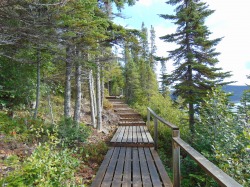Boardwalk empire

History is being made in Rigolet, Labrador with the recent completion of one of the world’s longest wooden boardwalks.
And thanks to a partnership with Memorial University archaeologist Dr. Lisa Rankin, visitors have a unique destination to visit after their nine kilometre trek along the waterfront and between the forest and the shore.
Three late 18th century Inuit homes can be found at the end of the boardwalk, following three years of excavation by Dr. Rankin and her team.
Double Mer Point was originally recorded as an archaeology site in 1968 by William Fitzhugh, who is now the senior curator of the Arctic Studies Center at the Smithsonian Museum of Natural History.
“In 2012, the town of Rigolet contacted me to see if I was interested in excavating the site as they had plans to extend the boardwalk and rebuild the three winter houses as a tourist destination to show how their ancestors had lived. To do this they needed the site excavated first,” said Dr. Rankin.
At the time Dr. Rankin was just finishing the excavation of several Inuit sites further south on the Labrador coast.
“By that point I had learned a lot about how the Inuit lived in the south, but the kind of household excavation I do wasn't common further north. I was beginning to realize that to understand whether the patterns of life I saw in the southern Labrador were common to all Labrador Inuit I needed comparative data from further north. I was thinking that some of the known Inuit sites near Rigolet would be a perfect place to start. I couldn't believe it when they called me - it was perfect timing.”
The project was completed thanks to another case of serendipity – a research team Dr. Rankin is associated with was awarded the Tradition and Transition research partnership with Nunatsiavut which funded the two remaining years of excavation required by the project.
The Inuit who lived at Double Mer Point had strong trading relationships with the French and British.
Materials collected from the site include European cups and bowls, an Ottoman pipe and even some truly ancient material from the Dorset Paleo-Eskimo people who lived in the same location thousands of years prior to the Inuit.
The settlement is adjacent to a spot where the water never freezes so seals could be hunted all year long.
“For the most part, Inuit living at Double Mer had a pretty traditional life. Being located near a rapid tidal current and a constant source of food means it was a perfect place to live,” said Dr. Rankin. “As a result we have discovered a considerable amount of material which tells us a lot about life there.” The excavations have provided data for three masters thesis to date.
Dr. Rankin praises the initiative of the town of Rigolet in developing the boardwalk.
“With the announcement of the new Mealy Mountain National Park the town is preparing for an influx of visitors as it will no doubt be one of the gateways into the park,” said Dr. Rankin. “I think it is wonderful how engaged Rigolet is with their history. They already have two small museums in town - the Netloft museum and the Lord Strathcona’s house that showcase different parts of the community's history. Now with Double Mer Point they can now show what life was like before Rigolet became the centre. And the boardwalk is amazing!”